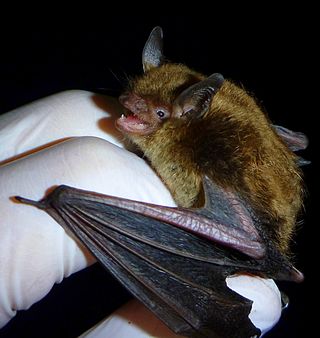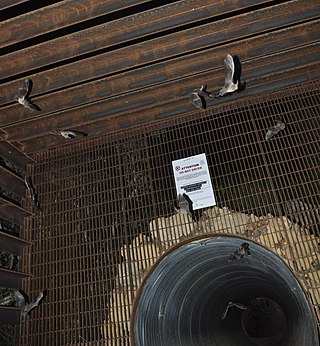Related Research Articles

Vampire bats, members of the subfamily Desmodontinae, are leaf-nosed bats currently found in Central and South America. Their food source is the blood of other animals, a dietary trait called hematophagy. Three extant bat species feed solely on blood: the common vampire bat, the hairy-legged vampire bat, and the white-winged vampire bat. Two extinct species of the genus Desmodus have been found in North America.

The Mexican free-tailed bat or Brazilian free-tailed bat is a medium-sized bat native to North, Central, and South America and the Caribbean, so named because its tail can be almost half its total length and is not attached to its uropatagium. It has been claimed to have the fastest horizontal speed of any animal, reaching top ground speeds over 99 mph (160 km/h). It also flies the highest among bats, at altitudes around 3,300 m (10,800 ft).
James Hemphill Brown is an American biologist and academic.

The big brown bat is a species of vesper bat distributed widely throughout North America, the Caribbean, and the northern portion of South America. It was first described as a species in 1796. Compared to other microbats, the big brown bat is relatively large, weighing 15–26 g (0.53–0.92 oz) and possessing a wingspan of 32.5–35 cm (12.8–13.8 in).

The Jamaican, common, or Mexican fruit bat is a frugivorous bat species native to the Neotropics.

The hoary bat is a species of bat in the vesper bat family, Vespertilionidae. It lives throughout most of North America.

The common noctule is a species of insectivorous bat common throughout Europe, Asia, and North Africa.

Wahlberg's epauletted fruit bat is a species of megabat in the family Pteropodidae. It is commonly found across southern Africa.

Peters's dwarf epauletted fruit bat is a species of megabat in the family Pteropodidae. It is found in Angola, Benin, Burkina Faso, Burundi, Cameroon, Central African Republic, Chad, Republic of the Congo, Democratic Republic of the Congo, Ivory Coast, Equatorial Guinea, Ethiopia, Gabon, Gambia, Ghana, Guinea, Guinea-Bissau, Kenya, Liberia, Mali, Niger, Nigeria, Rwanda, Senegal, Sierra Leone, Sudan, Tanzania, Togo, Uganda, and Zambia. Its natural habitats are subtropical or tropical moist lowland forests and moist savanna.

The little brown bat or little brown myotis is an endangered species of mouse-eared microbat found in North America. It has a small body size and glossy brown fur. It is similar in appearance to several other mouse-eared bats, including the Indiana bat, northern long-eared bat, and Arizona myotis, to which it is closely related. Despite its name, the little brown bat is not closely related to the big brown bat, which belongs to a different genus.

Bats are flying mammals of the order Chiroptera. With their forelimbs adapted as wings, they are the only mammals capable of true and sustained flight. Bats are more agile in flight than most birds, flying with their very long spread-out digits covered with a thin membrane or patagium. The smallest bat, and arguably the smallest extant mammal, is Kitti's hog-nosed bat, which is 29–34 mm (1.1–1.3 in) in length, 150 mm (5.9 in) across the wings and 2–2.6 g (0.071–0.092 oz) in mass. The largest bats are the flying foxes, with the giant golden-crowned flying fox reaching a weight of 1.6 kg (3.5 lb) and having a wingspan of 1.7 m.
Aeroecology is the discipline for studying how airborne life forms utilize and interact with other biotic and abiotic components of the atmosphere. The aerosphere is viewed as habitat and the way that organisms respond to and take advantage of the dynamic aeroscape has relevance to the ecology, evolution, and conservation of many of the world's bird, bat, insect, and plant species.
Donald "Don" William Thomas was a Canadian university administrator and ecologist specialising in ecophysiology. At the time of his death, he was dean of the Université de Sherbrooke faculty of sciences.

James Lloyd Patton, is an American evolutionary biologist and mammalogist. He is emeritus professor of integrative biology and curator of mammals at the Museum of Vertebrate Zoology, UC Berkeley and has made extensive contributions to the systematics and biogeography of several vertebrate taxa, especially small mammals.
Don Ellis Wilson is an American zoologist. His main research field is mammalogy, especially the group of bats which he studied in 65 countries around the world.

Rodrigo A. Medellín is a Mexican ecologist and Senior Professor of Ecology at the Institute of Ecology, University of Mexico (UNAM). Known for his work in bat, jaguar, bighorn sheep and other species conservation, his research has always been designed and conducted to advice conservation policy and conservation decision-making processes in Mexico and 16 other countries for over 40 years.

A maternity colony refers to a temporary association of reproductive female bats for giving birth to, nursing, and weaning their pups. The colonies are initiated by pregnant bats. After giving birth, the colony consists of the lactating females and their offspring. After weaning, juveniles will leave the maternity colony, and the colony itself will break apart. The size of a maternity colony is highly variable by species, with some species forming colonies consisting of ten or fewer individuals, while the largest maternity colony in the world in Bracken Cave is estimated to have over 15 million bats.

Emma Caroline Teeling is an Irish zoologist, geneticist and genomicist, who specialises in the phylogenetics and genomics of bats. Her work includes understanding of the bat genome and study of how insights from other mammals such as bats might contribute to better understanding and management of ageing and a number of conditions, including deafness and blindness, in humans. She is the co-founder of the Bat1K project to map the genomes of all species of bat. She is also concerned with understanding of the places of bats in the environment and how to conserve their ecosystem.
Sharlene E. Santana is a Venezuelan–American biologist, currently serving as the Curator of Mammals at the Burke Museum of Natural History and as a professor of Evolutionary biology at the University of Washington, in Seattle, Washington. Her research primarily focuses on the order Chiroptera (bats), and her work often engages with a diverse range of biological disciplines, including evolution, systematics, biomechanics, behavioral studies, and ecology. Santana has worked to expand opportunities for underrepresented minorities in STEM fields and has relied on innovative applications of technology to increase the amount of high-quality scientific information that is available to the general public.

Michael A. Mares is an American zoologist, academic, and author. He is the Emeritus Director and Curator at the Sam Noble Museum, as well as a Professor Emeritus in the Department of Biology at the University of Oklahoma.
References
- 1 2 3 4 Tarvin, Becca (March 14, 2010). "BU's Own Batman, Professor Kunz". The Quad. Retrieved August 3, 2018.
- 1 2 3 "Kunz Biography". BU. Boston University. Retrieved August 3, 2018.
- 1 2 Mangan, Katherine (July 24, 2011). "An Honored Biologist Works Into the Night for a Threatened Species". The Chronicle of Higher Education. Retrieved August 3, 2018.
- ↑ Fenton, Brock; Tuttle, Merlin (2012). "A tribute to Tom Kunz". batcon.org. Bat Conservation International. Retrieved August 3, 2018.
- ↑ "Tiputini Biodiversity Station". BU. Boston University. Retrieved August 3, 2018.
- ↑ Boston University (February 18, 2011). "New discipline of aeroecology introduced". ScienceDaily. Retrieved August 3, 2018.
- ↑ Keim, Brandon (April 1, 2011). "Bats Are Worth at Least $3 Billion Per Year". Wired. Condé Nast. Retrieved August 3, 2018.
- 1 2 3 "The Thomas H. Kunz Fund". BU. Boston University. Retrieved August 3, 2018.
- ↑ M. Brock Fenton, Sharon Swartz (2020): Thomas H. Kunz (1938–2020). Nature Ecology & Evolution, vol. 4, p. 1002–1003, doi:10.1038/s41559-020-1224-4.
- ↑ "A Brief History of the First Twenty-five Years of NASBR". NASBR. Retrieved August 3, 2018.
- ↑ "Distinguished Alumni to be Honored". University of Central Missouri. 2003. Archived from the original on April 1, 2013. Retrieved August 3, 2018.
- ↑ Honeycutt, Christina (March 29, 2018). "Rebecca Branconi Receives the Thomas H. Kunz Award". BU. Boston University. Retrieved August 3, 2018.
- ↑ "'Bat Man' overcomes odds 1 year after crash". The Daily Free Press. October 29, 2012. Retrieved August 3, 2018.
- ↑ Kunz, T.H. (2013). Ecology of Bats. Springer Science & Business Media. p. 46. ISBN 978-1461334217.
- ↑ Jarvis, Claire. "Bat Ecologist Thomas Kunz Dies". The Scientist. Retrieved November 13, 2021.